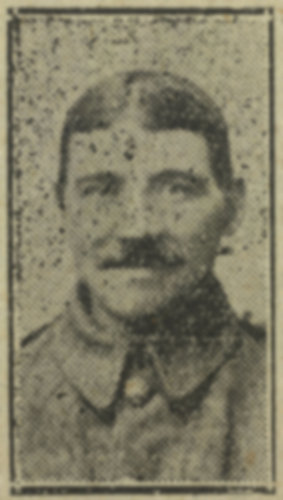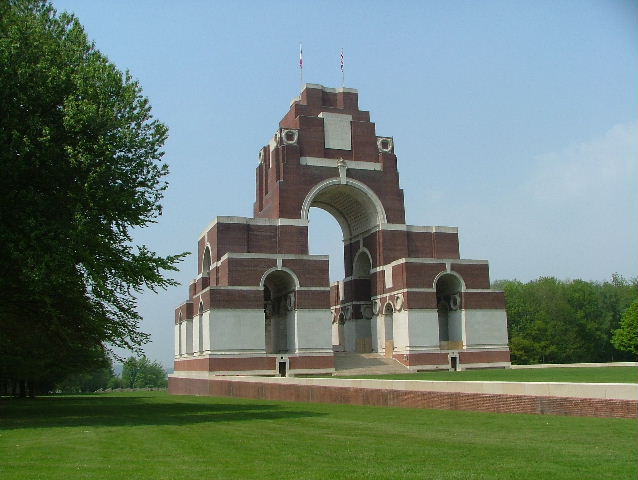Name
Joseph French
Conflict
First World War
Date of Death / Age
04/09/1916
27
Rank, Service Number & Service Details
Private
14223
Bedfordshire Regiment
1st Bn.
Awards: Service Medals/Honour Awards
1914 /15 Star, British War and Victory medals
Cemetery/Memorial: Name/Reference/Country
THIEPVAL MEMORIAL
Pier and Face 2 C.
France
Headstone Inscription
NA
UK & Other Memorials
Pirton Village War Memorial,
St Mary’s Shrine, Pirton,
Methodist Chapel Plaque, Pirton,
Pirton School Memorial,
Hitchin Town Memorial,
St Mary's Church Roll of Honour (Book), Hitchin
Biography
Joseph French, the son of William Henry French and Mary Ann Maria (née Reynolds) was born in Pirton and baptised in Pirton on August 4th 1889. When his parents married in 1879 both were recorded as ‘from Pirton’ and they are present in all the censuses between 1881 and 1911 and most list William as born in Kings Walden and Mary as a Pirton girl. The 1911 census confirms that they had nine children(*1), but that six had died.
Joseph began his schooling in Pirton in 1891 at just two, and was still at school in 1901, but by 1911 he was twenty-one, living with his parents around Little Green and working as a farm labourer for Thomas Franklin on Walnut Tree Farm. From his military records we know that their home was one of Holly Tree Cottages, which sit in Hambridge Way.
In response to one of Jonty Wild’s pleas for information, Brenda Dawson (of Pirton) wrote confirming that Joseph was her mother’s only brother and that he and her father, Arthur Castle, had enlisted at the same time. They must have been one of the first to do so, probably answering Lord Kitchener’s call to arms, ‘Your Country Needs You’.
Joseph, like many other Pirton lads, had been in the Hertfordshire Territorials. Their motivation to join was probably the mix of soldiering, socialising and a summer break away in a training camp. When war was declared, as a Territorial he would have been mobilised, but they were only required to defend home soil and could not be ordered to undertake overseas duty. As with many, if not all of the other Pirton ‘Terriers’, Joseph must have felt that it was his duty to volunteer.
He was first reported by the Parish Magazine, as being in the 3rd Battalion of the Bedfordshire Regiment and if that was the case then he was presumably transferred to the 1st. The fact that he joined the Bedfordshires was a little unusual as most of the Hertfordshire Territorials went straight into the 1st Battalion of the Hertfordshire Regiment.
The 1st Bedfords were a part of the regular army with a proud history and not a battalion created to service the war. They were in Ireland when war was declared, but were called to action very quickly. They landed in France on August 16th and fought in two of the very early engagements, Mons and Le Cateau. That includes them as part of the ‘Old Contemptibles’ - so called because the British Expeditionary Force (BEF) was so small that Kaiser Wilhelm II called it ‘General French's contemptible little army’. In August 1914 the BEF was tiny in comparison to the German Army, just 110,000(*2) men facing vastly superior numbers, but they fought incredibly bravely and with immense discipline. They were continually forced back by what should have been overwhelming numbers, but fought so well that the Germans believed they were a much larger force with substantial reserves. It is probable that Joseph joined the Battalion some time later in order to replace losses. The Division of which they were part had suffered 5,000 casualties by the end of November and took up a purely defensive role before moving first to Ypres in Belgium early in 1915, to Loos later in 1915 and then to the Somme in 1916. Joseph’s overseas service started on 12th June 1915, he would have quickly been in the thick of the action.
He was killed in action on September 4th 1916 and the Battalion’s war diary provides the details of their movements up to that date. After some heavy fighting in July they were bivouacked on August 2nd. They had a good rest with some training, a church parade, boxing and football tournaments and a Regimental sports day. Officers were even granted 48 hours’ leave. As they were preparing to move back into the trenches the weather deteriorated with heavy rain and storms between August 28th and the 30th. On the 31st they moved to the reserve section of the Silesia trenches and then at 8:00pm, when they relieved the 12th Gloucesters, were welcomed with ‘gas and tear shells’ – presumable gas and tear gas shells.
The recent weather had been very wet and the trenches required improvement, so on September 1st 276 men formed working parties working day and night. After more gas shelling, the British Artillery retaliated on the 2nd with bursts of rapid fire from the 18-pounder guns. That evening, nine men were wounded from a single shell, recorded as ‘a peculiar type, it burst on the parapet and burst in reddish light and formed no crater.’
Strangely, given Joseph’s death on the 4th, the war diary records nothing of interest between the 3rd and the 6th, but that was because they were too busy fighting. An investigation of the Battalion’s war orders reveals that they were part of the 13th Infantry Brigade Operation attack on Falfemont Farm due to start on the 3rd, the day before Joseph died. Without any other information it seems most likely that he was killed in that attack.
This attack formed part of the Battle of Guillemont and Falfemont Farm was a key German stronghold to the south-east of Guillemont. The bombardment, as preparation for the attack, began on the Saturday, September 2nd. Early on the 3rd, before zero hour, two battalions from the 20th (Light) Division crept forward and took the Germans by surprise. The main attack was launched at noon and they succeeded in advancing, but only after very hard fighting. They took Guillemont, but not Falfemont Farm. On the 4th, the day Joseph died, another attempt was made and the farm finally fell early on the next day.
His comrade and chum in the Bedfordshires, Private Kilby from Stevenage, wrote to his sister asking her to let Mrs French of Pirton know that her boy had been killed. Whether as fact or kindness is uncertain, but he said that he was killed instantly: ‘Pte French was going over the parapet of the trench in the attack when a bullet entered the centre of his forehead’. Private Kilby said that he visited his grave. If true then his grave must have been lost or destroyed in later action, because Joseph is commemorated on Thiepval Memorial meaning that he has no known grave. This often means that the body was buried, destroyed by shelling or lost in no-man’s land when recovery was too dangerous to be attempted, but it can also apply to men who were buried, but their graves or markers were subsequently destroyed in later actions.
Thiepval is an awe-inspiring memorial near the village of the same name in France. A huge brick-faced structure, which dominates the surrounding countryside, but it is difficult to understand its visual impact if you have not been there. It is ‘the’ memorial to the missing of the Somme and names 72,092 men, of which ninety percent died between July and November 1916. Even with this great number they are only the men with no known grave from the United Kingdom and South Africa. The remaining men from other Commonwealth countries who shared a similar fate are commemorated elsewhere.
In the first Battle of the Somme, which lasted from July 1st to November 1916, the total British Army casualties were 654,751, including 127,419 dead(*3). French casualties were 204,253 and German casualties estimated as 465,000 to 680,000. In some places the allies had gained as much as 7 miles, in others nothing at all.
(*1) Only seven can be named at this time and they are Emma (b 1879, d 1880 age 16 months), John (b 1881, d 1882 aged twenty-one months), Kate (b 1883), Annie (bapt 1885), Joseph (bapt 1889), Henry (b 1891, d 1901 aged nine) and George (b c1895, d 1901 aged six). The two who are unnamed probably died at a much younger age.
(*2) Of those 110,000 men over 86,000 were wounded or killed.
(*3) British Army numbers usually include all Commonwealth soldiers.
Additional Information
Text from the book: The Pride of Pirton
Acknowledgments
The Pride of Pirton book – www.pirton.org.uk/prideofpirton Chris Ryan / Tony French / Jonty Wild



